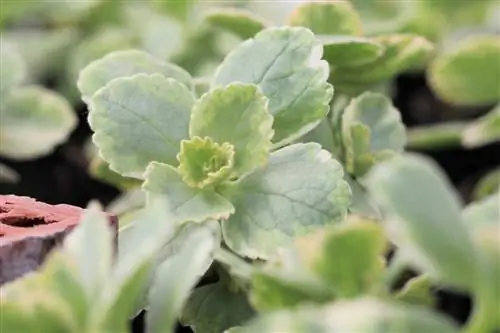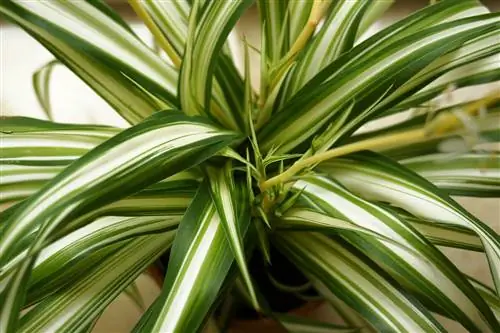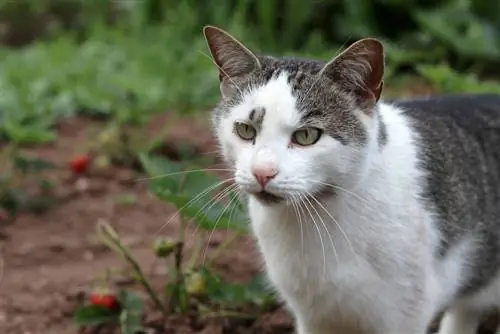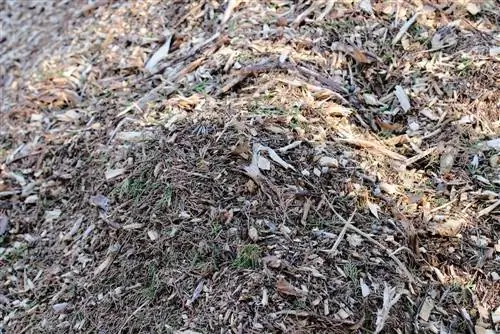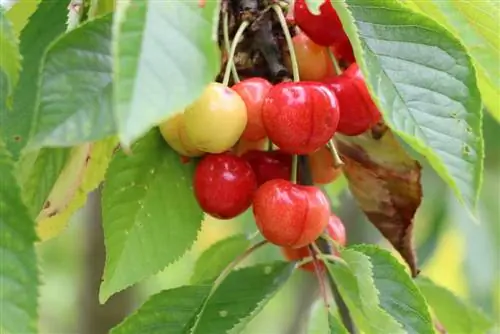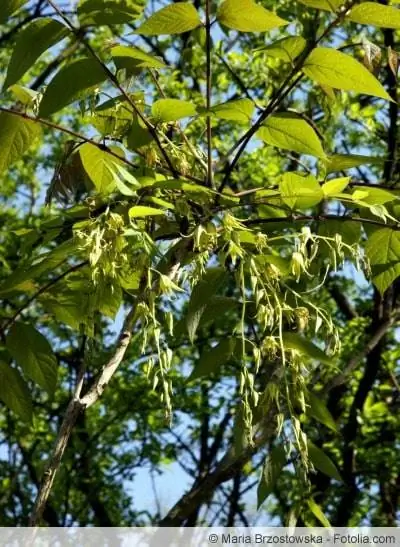- Author admin [email protected].
- Public 2023-12-17 03:39.
- Last modified 2025-06-01 06:48.
Other names are more appealing, such as Elfengold, Elfenblume or Duftheinrich. The oft-made remark that the harp bush (Plectranthus caninus) is not particularly attractive is lost on closer inspection. The small, filigree flowers have a pretty purple color and look great in any garden.
Origin of the harp bush
The harp bush originally comes from the southern hemisphere. The piss-off plant in particular has its home in South and/or East Africa. Other varieties come from Central or South America or Asia.
Effect of the harp bush
The plant owes its protective effect to the essential oils that the shrub regularly secretes through its nettles. The oils contain menthol and have a repellent effect on dogs, cats, rabbits and even martens. Animals often stay several meters away because this smell is so intrusive for them.
By the way:
The tobacco bush also belongs to this genus and is even often used against moths.
But there are also reports that deny its effectiveness and cause great disappointment. The number of plants, age and weather often seem to have an influence on the smell. There are statements that some varieties actually attract cats instead of scaring them away and invite them to take a “plant bath”. Despite its effects, the plant is not poisonous and can be used safely in a household with children.
Types of Harp Bush
In addition to the piss-you shrub, four other varieties from the mint family are regularly offered:
- Plectranthus coleoides - the frankincense plant with its white-green leaves. It has hanging shoots and is also often offered in hanging baskets or as an addition to a flower box for the balcony,
- Plectranthus fruticosus - the moth repellent with its white-green patterned leaves,
- Plectranthus oertendahlii - an autumn-flowering variety with rather runner-like shoots,
- Plectranthus nummularius - which is also a beautiful hanging plant because it is very bushy when cut regularly.
Harp bush location
In keeping with its origins, this plant particularly likes it to be warm and partially shaded to sunny. Several hours of sunlight are mandatory, otherwise the leaves will lose their beautiful color or pattern. If there is not enough sun, the shrub simply sheds a large part of its leaves or the new shoot produces far fewer leaves. The warmer and sunnier the harp bush is, the more lush the flowers appear in spring to early summer. The piss-you plant has very poor tolerance to sustained temperatures below 12 °C. The soil should be optimal. Nutrient-rich, loose and porous soil forms the ideal condition for magnificent growth. You can help with leaf mold and compost.
Harp bush - care
In the hot and sunny weeks, i.e. during the main growth phase, the shrub needs a lot of water. The root ball must not dry out, but waterlogging is difficult to tolerate. Whereas during the resting phase, watering is only allowed moderately. The hanging or lying shoots need a particularly large amount of water.
- For special care, the plant can be sprayed with water early in the morning and in the evening on particularly hot days.
- When growing, the shrub needs to be fertilized every two weeks.
- When kept in containers, liquid fertilizer is recommended; when cultivated in the general garden, a complete fertilizer can be applied around the plant.
- During the rest phase, fertilization is completely stopped.
The plant is otherwise easy to care for, not susceptible to disease and rarely affected by pests. In the summer months, an infestation of aphids may be possible, which can be removed either by a vigorous jet of water or by the usual means. The nicest way would be to use ladybugs.
Tip:
Houseplants can also be affected by aphids, especially in summer. Then we recommend giving the shrub a little shower.
A special cut is not necessary. If the bush becomes too large or varieties that form runners can be kept in check by regular pruning.
Propagation of the harp bush
The propagation is possible via head cuttings, the length should be 6-8 cm. The lower pairs of leaves are removed and then stuck directly into the ground. Ideally, everything should be placed bright and sunny to promote rooting. It is important to ensure that watering is only allowed moderately.
- Older plants should be replaced after a few years as the plants lose their beauty with age.
- For some varieties this can be as early as two years. 3-4 cuttings are enough for one pot.
- There is no wrong time for cuttings, this can be done all year round.
- The ideal time for this is autumn.
Overwintering the harp bush
The plant is not hardy; temperatures below 12 °C cause long-term problems. However, overwintering in pots at a moderate temperature of 12-15 °C can be done without any problems. Provided it is cool and dry. Staying in a dark cellar is not recommended as the shrub tends to “go rot”. In general, the harp bush is a beautiful houseplant. Also suitable for hydroponics. However, it should be repotted annually.
Whether as an effective weapon against all domestic animals or as an accompaniment to dominant plants to underline their visual impact, the harp bush is undemanding and develops on its own with appropriate care.
What you should know about the harp bush in brief
The harp bush originally comes from Southeast Asia and belongs to the mint family. Its effect on dogs, cats and rabbits is well known and has been confirmed several times. The scents, such as menthol, disturb the sensitive noses of the animals and drive them away from the garden. However, the smell is not perceived by humans. The so-called piss-you plant, which drives cats and dogs out of the garden with its smell, is a special breed of the harp bush. It has the same requirements for location and care as the other types of shrub.
Suitable location for the plant
- The harp bush needs a bright location; semi-shady or sunny places are ideal.
- The shrub will not thrive in the shade; it needs a few hours of direct sunlight every day.
- It indicates a location that is too dark by fading leaves.
- It also tends to grow quickly with small leaves when there is a lack of light.
- The shrub feels most comfortable at 16° and 21 °C.
Demands on the soil
- The plant requires loose and porous soil with a high nutrient content.
- The soil in the garden should therefore be enriched with compost.
- Harp bush does not tolerate congested moisture well, it prefers it to be a little dry rather than too moist.
- If the soil in the garden is firm and clayey, it is recommended to keep the harp bush in pots with leaf mold and compost.
Planting and caring for the harp bush
- The shrub, which comes from southeast India, is sensitive to frost.
- Therefore, it should only be planted outdoors from the end of May.
- A portion of flowering plant fertilizer every 14 days stimulates flowering.
- There is no way to extend the flowering phase, so they can remain on the plant to obtain seeds.
Pest infestation and diseases
- The harp bush is not prone to diseases such as rust or fungus, and it is also avoided by most pest insects.
- Only aphids can become a pest on the plant.
Overwintering the piss-off plant
- In winter the harp bush needs a cool room, temperatures of 12 to 15 °C are sufficient, it should never get colder than 10 °C.
- The tendency to horny means that the room must be very bright.
- You may need to use a grow light lamp to provide enough light.
- During this time, the shrub is neither watered nor fertilized, but the soil should not dry out completely.
breeding of the harp bush
- It is possible to grow cuttings from the seeds of the shrub, but head cuttings are usually used.
- Head cuttings are created from approximately 6 cm long shoot tips of older plants. These can be cut all year round.
- With regard to wintering, late summer is the appropriate time.
Pet Precautions
Not all types of harp bush release scents. The variety known as the piss-off plant releases an essential oil through nettle hairs that smells like menthol. Other varieties secrete substances that smell like incense, and other varieties are even used as spices in the kitchen. The harp bush is never poisonous, so it can easily be used in the garden to drive away animals. Since dogs and cats find the smell unpleasant, the location in the house should be chosen with care. It is certainly not appropriate to place the plants near animal resting places. The smell is perceived as disturbing by animals even at a distance of two meters. People hardly notice the smell.
Effect of the piss-off plant
Many garden owners who have bought the piss-off plant are not at all satisfied with its effect. Quite the opposite. Animals, especially cats, would love them. They first roll around in it and then eat it completely bare. It's best to try it out once, maybe it will work in your own garden. One plant costs around 3 euros, 8 around 15 euros. Maybe the quantity brings success?

